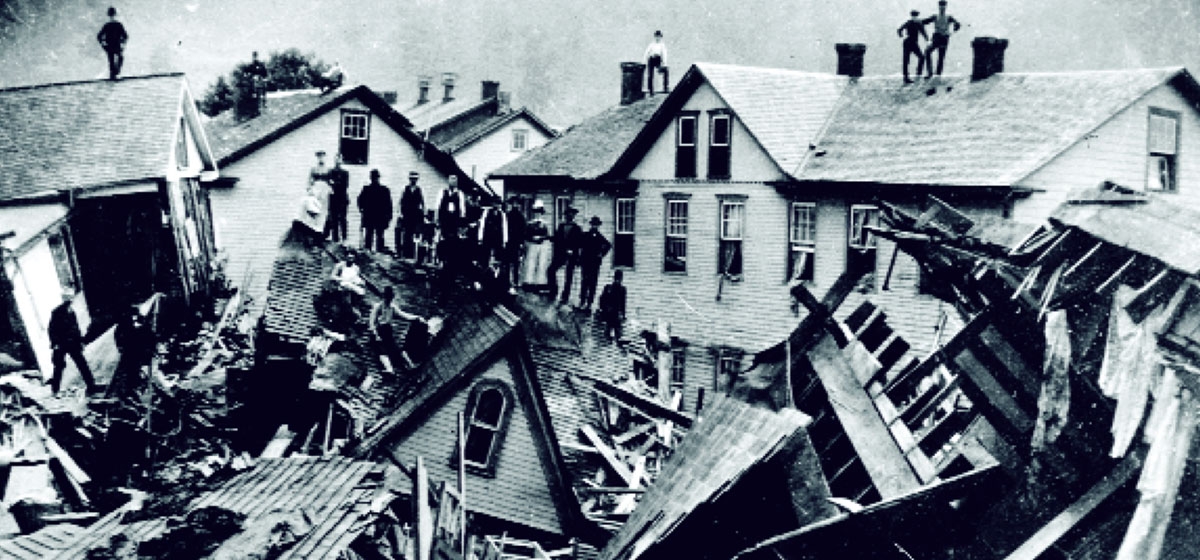
On May 31, 1889, 20 million tons of water broke through the South Fork Fishing & Hunting Club’s earthen dam on Lake Conemaugh and destroyed almost everything in its path.
Hardest hit was the city of Johnstown, 14 miles downstream. When the waters (and ensuing fires) abated, the toll included 2,209 dead with countless homes and businesses destroyed. It was the first major relief effort for Clara Barton’s newly formed American Red Cross, and over $3.7 million was donated worldwide for the recovery.
Many blamed the members of the exclusive, 9-year-old, private club for placing too much stress on the dam and not maintaining it adequately. The 61 members were industrial titans with names such as Frick, Carnegie, Phipps and Reed. Ensuing lawsuits blamed the members, but the cases, successfully defended by the Knox & Reed law firm (now Reed Smith), placed cause for the flood on the 8–10 inches of rain that had deluged the area, calling it, in short, an act of God.
There is a lot of finger pointing when it comes to the Johnstown Flood. Should the club have better maintained the dam? Should the townspeople have heeded the warnings about the impending catastrophe? Should club members have been responsible for assuring that all structural mechanisms of the property were sound?
Insight into all of this is available at multiple museums in the Johnstown area. To say which is best is like picking a favorite child—each has its own attributes.
Start at the Heritage Discovery Center. Opened in 2001 in a former brewery, this museum is an interactive gem. The first floor exhibit, “Through Immigrant Eyes,” has visitors assume identities of immigrants and follow their path from European homelands to the steel mills and life experiences of Johnstown residents of the late 19th and early 20th centuries. It gives exceptional insight into the lives of those affected by the flood. There is also a gallery, currently displaying striking photographs of steel-making. The Johnstown Children’s Museum (upstairs) allows children to explore, learn and play, all within the framework of a Johnstown theme. Finally, be sure to watch (and feel) “Mystery of Steel,” a fascinating look at the steel industry and Johnstown’s pivotal role in it.
Just around the corner is the Johnstown Flood Museum, dedicated to depicting the fatal event that is synonymous with the town. From Charles Guggenheim’s riveting, Academy-Award-winning documentary to the many artifacts, documents and animated map, you will get a thorough understanding of the fate of many of the immigrants whose lives you just explored. The Heritage Association website gives details on these two museums and everything else included with a single admission fee.
Finish your trip with a visit to the Johnstown Flood National Memorial, part of the National Park Service. At the Visitor’s Center, you can watch the gripping, dramatically haunting film, “Black Friday.” There are also exhibits, models and maps that depict the events of the flood. Walkways out to the remains of the dam give an overview of the scene of the disaster. The nearby clubhouse of the South Fork Fishing & Hunting Club is open seasonally, and gives a glimpse of its past glory.
In several hours, you will become immersed in this tragic event, gain perspective and learn surprising facts. For example, there is no evidence that Andrew Carnegie ever visited the club, although he is often named as one of the club members responsible for the failed dam disaster. Another: By 1860, the Cambria Iron Company was the leading steel producer in the U.S. Johnstown was also the leading barbed wire manufacturer for the second half of the 18th century.
No trip to the area would be complete without a visit to Coney Island Lunch, a fourth-generation restaurant specializing in chili dogs and “Sundowners” (cheeseburgers topped with fried eggs, chili, mustard and onions). Also, be sure to ride the Inclined Plane—the steepest vehicular incline in the world.
Though marred by a great tragedy, Johnstown is a fascinating town rich with history, and its museums and historic buildings are definitely worth the drive.
For more information, please visit the Johnstown Area Heritage Association at jaha.org and the Johnstown Flood National Memorial at nps.gov/jofl.




